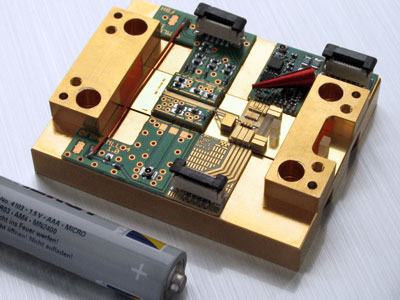| Posted: March 15, 2010 |
Ferdinand-Braun-Institut showcases latest developments at Laser Optics Berlin |
|
(Nanowerk News) Due to their reliability, small size, high output power and high efficiency, semiconductor lasers are increasingly gaining market share in many laser applications. Laser Optics Berlin, held from March, 22th to 24th, is one of the key industrial trade shows in this growing field, and is an important networking opportunity. The accompanying technical conference showcases the strong cross-linking between research and industrial application within the laser optics market. The Ferdinand-Braun-Institut, Leibniz-Institut fuer Hoechstfrequenztechnik (FBH) will be presenting the latest developments in laser technology at Laser Optics Berlin both at its trade show booth (Hall 18, booth 404), as well as during the technical conference.
|
|
Compact laser systems for displays
|
|
The performance, size and cost of many display applications would be dramatically improved by the use of semiconductor lasers, from mass market applications such as laser television to specialist niche apps such as flight simulators and displays for planetariums. The FBH’s scientists are developing compact high-power visible light sources, and have made dramatic progress towards their real application in commercial systems. Recent prototype units used hybrid –micro-bench technology to reliably produce more than 1 W of continuous wave blue light in a high quality beam at 488 nanometers (nm). 488 nm was chosen as a demonstrator wavelength due to its immediate commercial importance (it is an established wavelength for many spectroscopic applications) but also for use in display technology, where there are no currently commercially available compact high-power semiconductor laser solutions with such a power or beam quality. The hybrid micro-bench used frequency conversion to transform infrared laser light with a wavelength of 976 nm into blue light by means of a non-linear crystal – the frequency is doubled (wavelength halved) to 488 nm. Previously, such powers could only be produced using an experimental set up on an optical table, which occupied more than one square meter of laboratory space. Using FBH’s micro-bench technology, this has been miniaturized to a unit the size of a matchbox (25x10x50 mm). These micro-bench designs can be flexibly adapted to all other required wavelengths.
|
|
The reliable, reproducible manufacture of these hybrid diode laser systems was made possible by FBH expertise in high-precision mounting of micro-optic elements. The development of a custom tailored thermal management scheme was also critical, due to the strongly divergent requirements of the diode laser and the crystal used for frequency conversion. The next development step will be to transfer the concept to lasers emitting blue light at a wavelength of 460 nm and green light at 530 nm – these are the optimum wavelengths for display technology. The necessary pump sources with 920 nm for blue and 1060 nm for green lasers have already been developed.
|
 |
| Pulse picker for precise selection of single laser impulses. (Image: FBH/Immerz)
|
|
Pulse picker for ultra-short light impulses
|
|
A further new development from the FBH is a novel pulse picker technology that allows FBH to pick out single pulses from the high-frequency pulse chain generated by a semiconductor laser operating as an unstable resonator. Laser systems with pulse pickers can be used for example in laser material processing as seed lasers for fiber lasers, in biomedical analytics based on fluorescence spectroscopy, and in laser light detection and range finding. Using FBH’s pulse picker technology, a compact module completely based on semiconductor technology is now available for the first time, that can deliver ultra-short light impulses of less than ten picoseconds with almost any desired pulse repetition rate from the Kilohertz to the 100 Megahertz range. Demonstrator modules combine high-power pulse generators with a pulse picker and the associated drive electronics into a compact unit. The modules are constructed using a tailored optical designs to efficiently couple light between the optical elements, building on FBH’s high-power diode laser technology. The radio frequency (RF) control electronics were also developed at the FBH using their in-house gallium nitride technology. The pulse picker technology has combined FBH core competencies in RF technology, electronics and high-power diode lasers, to produce high performance low cost, compact pulse sources suitable for use in multiple commercial applications.
|
|
Highly efficient diode lasers with an extremely narrow spectrum
|
|
Additionally, the FBH presents new highly efficient, powerful broad area diode lasers with built-in gratings for narrow linewidth operation at Laser Optics Berlin. By careful optimization of design and material quality, the optical output power of these sources could be more than doubled compared to the up to now most powerful available DFB lasers. Specifically, for the first time world-wide more than 10 Watt could be delivered from a 100 µm laser stripe in a spectral range of significantly smaller than one nanometer. This laser additionally operates with a high power conversion efficiency: the ratio of electrical energy transformed into light add up to 58 percent and is therefore scarcely below conventional high-power diode lasers, which however have a significantly broader spectral width of 2 to 3 nm. These novel diode lasers are a cost-saving option for laser sources, as no external grating is needed for operation within a narrow spectral line. Such narrow linewidth sources are required for new high-performance industrial laser systems, where wavelength-multiplexing can be used to combine the output of many lasers into a single spot (say the input of a 100 µm core fiber) via a wavelength selective element. Such systems lead to a dramatic increase in the delivered power density, enabling high-speed cutting and welding. A further application field for these devices is their use as pump source for fiber and solid-state lasers in materials processing, where they enable narrow absorption lines to be pumped, for higher overall system performance.
|

